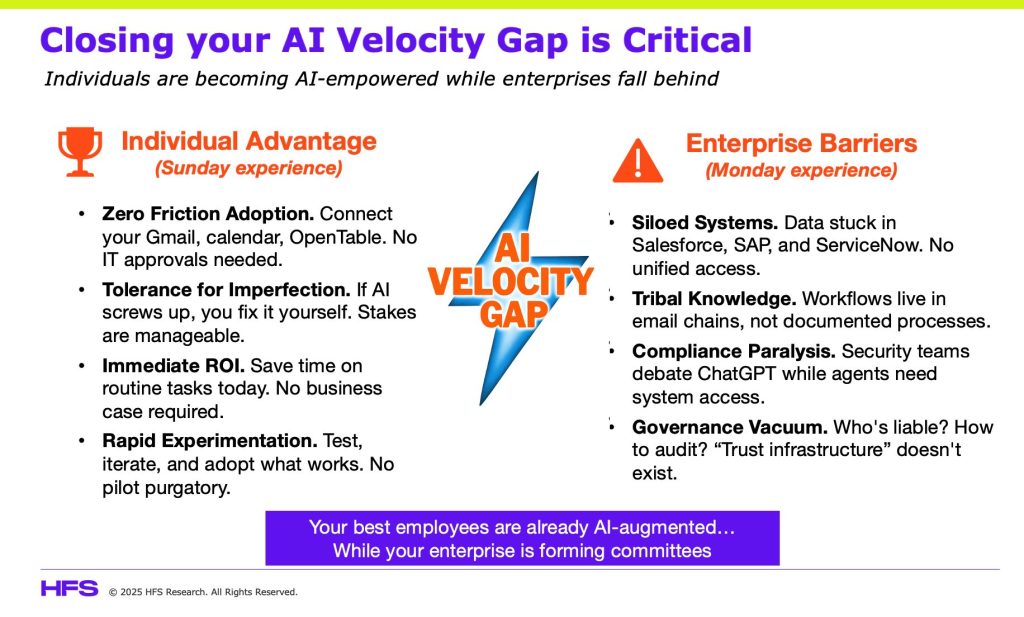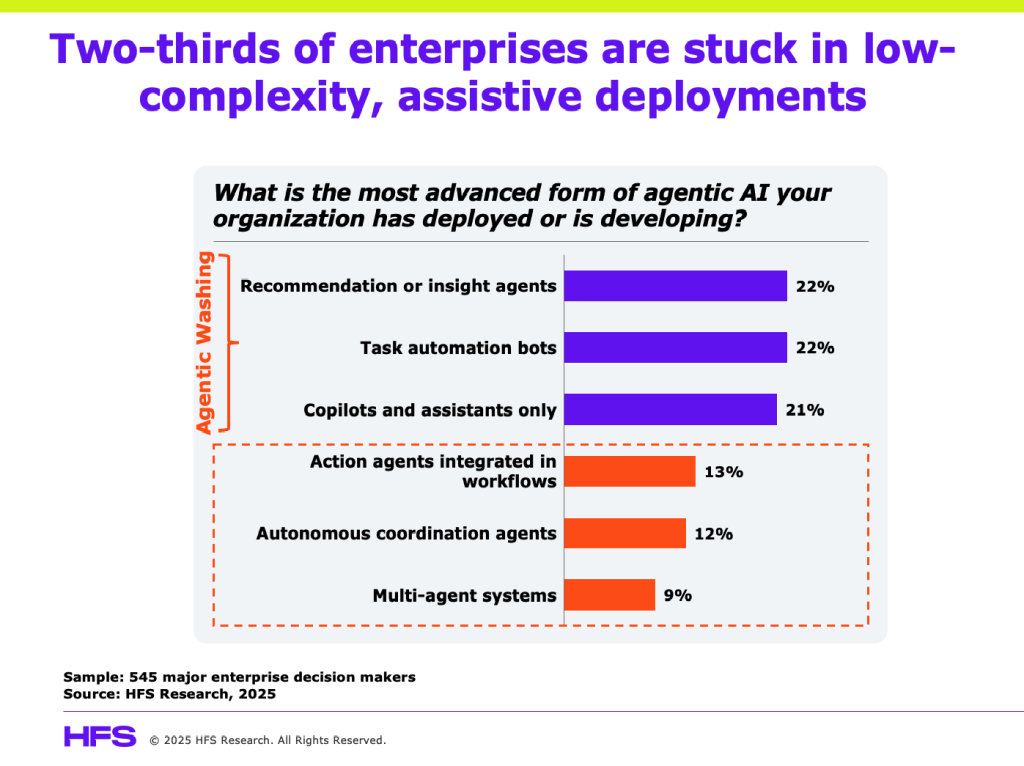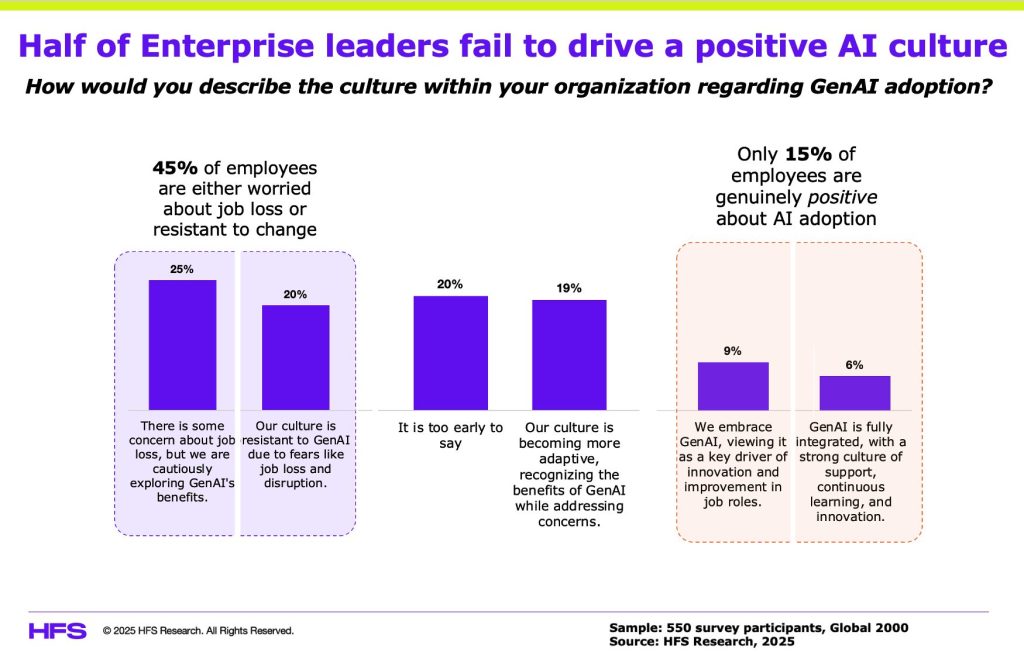On Sunday, employees live the AI dream: frictionless, instant, empowering. They connect Gmail, Calendar, and OpenTable without asking permission. They fix mistakes, automate workflows, and see instant ROI on everyday tasks.
On Monday, they crash into enterprise reality: data silos, email chains, compliance debates, and governance frameworks that exist only in PowerPoint.
Your best employees are already AI augmented.
Your enterprise is still forming committees.
This is your AI Velocity Gap, and it’s probably widening every day
Within the next 18 months, your employees will be working side-by-side with agentic AI, while your enterprise still debates policies and pilots. The AI Velocity Gap is the widening divide between how fast individuals are adopting AI to get work done and the speed with which enterprises are enabling it. It is the distance between human ambition and enterprise readiness for AI.
The AI Velocity Gap is no longer a concept. It’s the performance metric that decides whether you’ll lead the AI-first economy or be left behind.

You can’t close gaps that you can’t measure
The biggest failure in enterprise AI today is the inability to quantify progress. According to a new WalkMe survey, 78% of employees admit to using AI tools not approved by their employer, while only 7.5% have received extensive AI training. This isn’t rebellion. It’s your workforce solving problems faster than your IT department can write policies.
To reinforce this point, a recent HFS study of 545 global 2000 firms clearly shows that two-thirds of them are merely paying lip service to agentic AI, running low-level activities such as task automation (RPA) and copilot assistants, which we term as “agentic washing”:

This isn’t just semantic confusion. It’s strategic misdirection. When enterprises rebrand basic RPA as ‘agentic AI,’ they’re measuring the wrong outcomes and celebrating the wrong wins. Real agentic AI makes decisions, adapts to context, and operates with minimal human intervention. Task automation and copilots are table stakes, not transformation.
To understand the size of your AI Velocity Gap, start tracking three speeds that define your transformation
Speed 1: Adoption velocity. How fast are employees deploying AI tools compared with official enterprise initiatives? Count the number of unsanctioned tools in use, prompts executed per week, and AI workflows created outside IT control. Recent data shows 80% of SaaS logins for AI tools bypass IT oversight entirely.
Speed 2: Enablement velocity. How quickly your infrastructure supports AI-driven work. Measure API availability, time to access enterprise data, and how much of your process knowledge is actually documented. MIT’s Project NANDA found that only 40% of companies provide official AI subscriptions, yet 90% of employees use personal AI tools daily. When your sanctioned enterprise systems can’t compete with consumer ChatGPT, your infrastructure is the bottleneck.
Speed 3: Cultural velocity: How ready your leaders are to let AI make real decisions. Track executive sign-off cycles, experiment-to-production ratios, and how often AI output is used in live operations. Despite $30-40 billion invested in generative AI initiatives, only 5% of organizations see transformative returns (MIT’s Project NANDA). The other 95%? Still measuring activity instead of outcomes. In addition, recent research from HFS is showing how so many enterprises are failing to establish a positive culture when it comes to enterprise GenAI adoption. These measures expose where your enterprise is crawling while your people are sprinting. Nowhere is this more visible than in organizational culture:
Leadership Must Confront the Culture Crisis. Half of enterprise leaders are failing to drive a positive AI culture, and the data reveals why transformation stalls. HFS Research found that 45% of employees are either worried about job loss or resistant to change, while only 15% are genuinely positive about AI adoption. This isn’t a technology problem. It’s a leadership vacuum. When a quarter of your workforce fears for their jobs and another fifth actively resists GenAI due to disruption concerns, pilots will never scale to production.
Leaders who win build trust through transparency: they communicate how AI augments roles rather than replaces them, celebrate employees who co-create with AI tools, and reward outcomes over activity. The 15% who embrace AI as a driver of innovation aren’t lucky. They work for leaders who made a choice to lead with conviction instead of caution. The culture gap is closeable, but only if executives stop debating policies and start demonstrating that AI makes work better, not obsolete.
Turn AI experiments into AI operations
Once you’ve measured the size of your AI Velocity Gap, the next step is to close it with intent and precision.
Transform pilots into platforms. Stop running disconnected proofs of concept. One financial services firm discovered 27 unauthorized AI tools being used for zip code analysis in sales workflows. Instead of shutting them down, they built compliant data paths that preserved the productivity gains. Rebuild one business process entirely around AI and scale it. You will learn more from one operational success than from ten experiments.
Recast governance as enablement. Treat compliance like infrastructure, not red tape. In organizations that provide solid AI training and clear, open policies for using AI tools while ensuring data security, our research shows shadow AI adoption drops by 50% or more. Automate policy checks and build real-time audit trails so AI decisions can move as fast as your market.
Build an AI-first workforce. Every employee should learn to express intent through natural language tools. A study from AI4SP reveals that developers using AI coding assistants cut task times by 33%. Legal teams slash document analysis from 2 hours to 15 minutes. Content teams reduce their reliance on human translators by 90%. Train employees to think like workflow designers, not passive users. This is the new enterprise literacy.
Avoid the pitfalls that will seize your momentum
Governance bloat that drowns innovation in paperwork. You build approved vendor lists that expire before employees finish compliance training. By the time Legal signs off, your people have already found better tools.
Data delusion that mistakes “clean enough” for good enough. When it takes longer to configure your AI tool than to do the work manually, you don’t have an AI problem. You have a data architecture problem that no amount of vendor demos will fix.
Talent inertia that protects comfort zones over curiosity. 40% of enterprises lack adequate AI expertise internally (Stack-AI, 2025). Worse, 31% of employees, including 41% of Gen Z, admit they’re actively sabotaging your AI strategy by refusing to use the tools you bought (Writer/Workplace Intelligence, 2025). They’re not confused. They’re voting with their feet.
Pilot fatigue that celebrates activity instead of adoption. 75% of enterprises remain stuck in pilot mode, unable to reach scale or full adoption (HFS Research, 2025). The gap between the 25% who succeed and the 75% who don’t isn’t technical capability. It’s leadership conviction.
Every one of these is a symptom of leadership fear, not technical limitation.
Create momentum that employees can feel
Your teams already see AI’s power in their daily tools. Harness that energy instead of suppressing it.
Launch internal Agent Labs where cross-functional teams can safely experiment with enterprise data. A technology company preparing for an IPO discovered an analyst using personal ChatGPT Plus to analyze confidential revenue projections under deadline pressure. The risk wasn’t the tool. It was the lack of a safe, sanctioned alternative.
Celebrate visible wins, not vague ambitions. Show hours saved, errors reduced, customers served faster. Make success tangible and repeatable. The enterprises that publicize their AI champions and their results create permission structures for broader adoption.
AI success is not just about tools, it is about teaching your people how to think and build with them. Gallup finds that employees who receive formal AI training are 89% more likely to view AI as highly productive and beneficial to their work. Boston Consulting Group reports that companies providing at least five hours of AI training and in-person coaching see far greater adoption and workflow redesign success. Training converts skeptics into champions faster than any pilot program.
Ignoring the AI Velocity Gap does not protect you, it compounds your vulnerability
Enterprises that ignore their AI Velocity Gap are not standing still; they are moving backward. The gap compounds silently every quarter, widening the distance between individual innovation and organizational inertia.
Talent walks. Skilled employees already using AI to accelerate work will leave for employers that recognize and reward their capabilities. A recent PwC study found that 52% of Gen Z workers would quit a job that limits their use of AI tools. AI fluency has become a career currency, not a novelty.
Shadow AI becomes shadow operations. When enterprises fail to provide secure, sanctioned AI environments, employees build their own. Sensitive data flows into public models, audit trails disappear, and compliance teams lose visibility. The result is not just risk, it is a fragmented operating model that no one controls.
Customers feel the lag. Competitors that integrate AI into customer support, sales, and service workflows will deliver faster, cheaper, and more personalized experiences. HFS predicts that 75% of customer interactions will involve some AI agent in the next 12 months. Firms that cannot match that pace will lose relevance, not just revenue.
Leaders lose credibility. Boards and investors no longer see AI as optional. In Q2 2025 earnings calls, more than 60% of S&P 500 CEOs mentioned AI as a top strategic lever. When executives keep “piloting” instead of delivering, they signal indecision, not prudence.
You build enterprise debt instead of enterprise value. Every delayed AI initiative adds layers of process debt, data debt, and talent debt that become exponentially harder to repay. The enterprise becomes structurally slower even as the market speeds up.
Bottom Line: The AI Velocity Gap is a leadership test, not a technical one
Technology isn’t holding you back. Leadership courage is. The firms that win the AI-first decade will not be the ones that perfect policy or vendor selection. They will be the ones that measure progress, reward experimentation, and move faster than their fear.
Your people are already crossing the AI chasm. The only question left is whether your enterprise has the conviction to follow.
Posted in : Agentic AI, AGI, Artificial Intelligence, Change Management, Employee Experience, GenAI, Generative Enterprise






